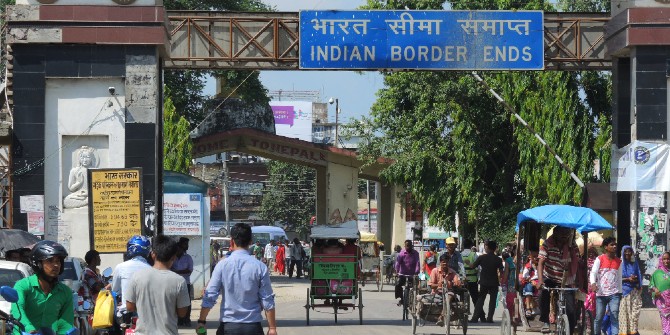The sudden closure of the Nepal-India border last year undermined the fundamental rights and dignity of returnee migrants, sparking widespread outrage and calls for action that went all the way to the Supreme Court. Yet the subsequent political crisis has hindered any meaningful policy interventions aimed at the marginalised migrants, says Nimesh Dhungana (LSE).
A year ago, the Nepali government’s abrupt decision to close the open Nepal-India border violated the dignity and rights of cross-border migrants, and sparked major public outrage. Hundreds of returnee migrants were left stranded across the Indo-Nepal border. While it was intended to minimise the risk of the virus spreading, the hasty closure of the border meant the migrants were forced to surrender their fundamental human right to seek the comfort of their homes in Nepal, as they faced the rising threats of COVID-19, a police crackdown and economic insecurity in India.
Poorly set up and cramped quarantine facilities failed to comply with basic standards of social distancing, and instead fuelled the risk of transmitting the virus. It was not only migrants returning from India who suffered from policy neglect. The Nepali government’s lack of diplomatic initiative in ensuring the safe and dignified repatriation of economic migrants forced Nepali migrants in the Middle East and south-east Asia to endure a climate of insecurity, fear and anxiety.
Indeed, the pandemic’s disproportionate burden on migrants is not limited to Nepal. Globally, the pandemic has led to the unprecedented use of government powers, preventing migrants from exercising their rights to health and information, and exposing the chronic lack of basic safety nets for historically disadvantaged groups across South Asia – most notably labour migrants and informal workers.

Crises, however, can also be ‘attention-grabbing’ events that force governments to tackle the socio-political harms facing marginalised communities. The border closure and ensuing hardship facing returnee migrants attracted collective outrage, with both mainstream and social media amplifying the struggles of the stranded migrants. Returnee migrants themselves protested against the government’s decision, calling it a violation of their fundamental right to return to the country. Investigative journalists, rights activists and advocates seized on the crisis as an opportunity to hold the government accountable. Indeed, the crisis sparked some transformative moments: for example, the government’s use of emergency powers to stop the return of migrants was challenged in the Supreme Court, and the Court urged it to ensure the safe and dignified return of the migrants and guarantee their right to adequate testing and treatment.
What happened to this crisis-induced political mobilisation? Did it last? Did the public outrage lead to innovation in governance and policy reforms that respond to the old and new demands of the migrants? A quick revisit of the year suggests a mixed political climate.
For a country like Nepal, much depends on political mobilisation that does not just involve brief outrage
Last June, Nepali youth took to the streets under the slogan ‘Enough is Enough’, deploying socially-distanced protest tactics and showing their discontent with the government’s slow response to the pandemic’s socio-economic toll. Yet the government’s response to these demands has been lacking. Then, in December, Prime Minister K P Oli unilaterally dissolved the parliament after months of political infighting within the ruling party, a crisis of democracy that effectively eclipsed the public health crisis. The Prime Minister’s move not only shifted media attention and ignited fresh political protests to reverse the crisis, but further deepened political polarisation. Although Oli’s move has recently been ruled unconstitutional by the Supreme Court and the parliament is now reinstated, the democratic crisis persists in the form of uncertainty over power sharing, together with an unprecedented controversy over the political conduct of the judiciary and legislative bodies, which are in theory expected to monitor and regulate the conduct of the executive. The ongoing political crisis and obstruction of parliamentary proceedings have stalled any meaningful deliberation over post-pandemic socio-economic packages, including concrete rehabilitation and reintegration programmes for the labour migrants, whose contribution has long sustained Nepal’s fragile economy.
As the COVID vaccine is rolled out in Nepal and elsewhere, the Nepali government has issued a fresh public health warning amid the threat of a new outbreak in India. With the persistent health crisis, questions remain about whether, when or how the pandemic will prompt the government to introduce health and economic reforms to redress the historical injustices facing disadvantaged migrants. For a country like Nepal, which is prone to recurring crises, much depends on political mobilisation that does not just involve brief outrage over the violations of dignity inflicted on migrants, but sustained societal pressure to make the government more responsive to their claims.
This post represents the views of the author and not those of the COVID-19 blog, nor LSE.





